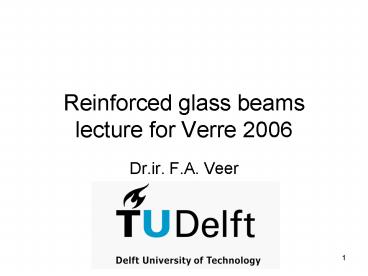Reinforced glass beams lecture for Verre 2006 - PowerPoint PPT Presentation
Title: Reinforced glass beams lecture for Verre 2006
1
Reinforced glass beamslecture for Verre 2006
- Dr.ir. F.A. Veer
2
Glass in architecture
- Glass has played an important role in
architecture as the material that opens up a
building to light. - An important example are the great rose windows
of the medieval cathedrals.
3
Cathedral of Notre dame , Paris
4
Glass in architecture
- Although these windows are very dramatic they
need extensive supporting masonry as they weaken
the structure.
5
Crystal palace, London , 1851
19th century greenhouse, Madrid, Spain
6
Glass in architecture
- Although glass appeared to take a leading role it
was still only a material that separated the
interior and exterior. - It was only some twenty years ago that glass
started to be used in a limited structural role.
7
Grand Serres of cite des sciences et de
lindustrie at la Villette
8
Glass in architecture
- This marks a transition from non-structural to
limited structural use of glass. - This also raised the important question
- How far can we go in using
- glass as a structural material ?
9
Glass as a structural material
- It also raises the question of what loads we can
put on glass in - Tension
- Bending
- Compression
- Bending will be the focus of this presentation
10
Glass beams
- Monolithic annealed float glass
- Tempered float glass
- PVB laminated tempered float glass
- Sentry glass laminated tempered float glass
- Cast resin laminated tempered glass
- Polycarbonate laminated glass
- Carbon fibre reinforced glass
- Stainless steel reinforced glass
11
ING office, Budapest
12
Glass museum, Kings Wingford, England, PVB
laminated roof beams
13
Apple store, New York , use of Sentry glass
14
Wolfson building of the medical faculty of the
university of Glasgow
15
IHK building , Munich
16
Carbon fibre reinforced glass roof beams for the
loggia di vicari
17
Stainless steel reinforced glass beam after
testing
TU Delft all glass paviljon 2004
18
Failure behaviour
stress
Monolithic glass
PVB laminated glass
Reinforced glass
PC laminated glass
strain
19
Stainless steel reinforcement
- In 1995 the ZAPPI research program started.
- Goals was to develop safe transparent components
for a transparent building of 202020 meters. - This means beams of large span, columns etc. as
well as the technology to put it together.
20
1997
Glass polycarbonate beam
21
2001
22
2002
23
(No Transcript)
24
(No Transcript)
25
2002
26
Glass box section reinforced beam, 2003
27
2003
Glass T-section post-tensioned beam
28
2004
29
Further improvement
- Although the 2004 result showed large and safe
beams can be made research is continuing in
several directions. - This with the following aims
30
Further improvement
- how to increase the ease of manufacture
- what is the required volume of reinforcement
- what is the optimum configuration for the
reinforcement - - what is the optimum configuration for the glass
- What is the best adhesive for the reinforcement
- What is the maximum length that can be attained
31
Ease of manufacture
32
Required volume of reinforcement
thickness
33
Reinforcement configuration
34
Adhesive type
Stainless steel reinforced glass bonded using GB
368 adhesive
Stainless steel reinforced glass Bonded using
araldite 2013 adhesive
35
configuration for the glass
36
configuration for the glass
37
maximum length
38
Conclusions
- The results so far show that reinforced glass
beams - can exceed the 6 meter length limitation imposed
by the standard glass panel size - can have a build in structural safety mechanism
which shows considerable deformation after
initial cracking and thus cannot collapse
spontaneously - can in theory be used as structural member of the
main load bearing construction - have a length limit of about 20 m
- can result in innovative architectural solutions
39
Conclusions
- The main obstacles to introduction of reinforced
glass beams are - the lack of an adequate knowledge base on which
to design the components - the problem in joining the glass components
together - the lack of knowledge about these components at
the architecture and engineering level - the lack of clearly applicable building codes for
the regulatory body - the need for specialised staff and expertise for
the contractor































